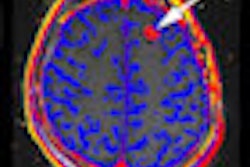
DUBLIN - In funding terms, imaging research is still the poor relation, and it will remain so until there is more collaboration and the field acts in a more concerted way to validate and standardize methods and technologies to support clinical translation, delegates heard at the World Molecular Imaging Congress (WMIC) on Saturday.
"We're at the noise level as far as the funding agencies are concerned," said Dr. Laurence Clarke, PhD, acting branch chief for Imaging Technology Development and Imaging Guided Intervention at the Cancer Imaging Program of the U.S. National Cancer Institute (NCI), during a spotlight session on research funding.
 In future biological research, greater use is likely to be made of imaging equipment and data. All photos are from the WMIC technical exhibition and are courtesy of Brendan Lyon, ImageBureau, imagebureau.ie.
In future biological research, greater use is likely to be made of imaging equipment and data. All photos are from the WMIC technical exhibition and are courtesy of Brendan Lyon, ImageBureau, imagebureau.ie.
Compared with disciplines such as proteomics and genomics, imaging lags behind, and science agencies perceive imaging research as being too complex, overly dependent on specialist operators, and lacking in standardization, he explained.
"Imaging methods are all over the map in terms of performance, and they're not standardized in any way," Clarke said.
Therefore, adoption of imaging data by science researchers often has been limited to date. Improvements in standardization could have a significant cost benefit for clinical research, because less imaging variation across different clinical trial sites would result in greater statistical power and the possibility of reducing trial sizes in certain settings, but he fears support for basic imaging research will dry up if it fails to demonstrate clinical translation.
The NCI Cancer Imaging Program has established two long-running research networks as part of the Network for Translational Research (NTR): Optical Imaging in Multimodality Platforms and the Quantitative Imaging Network for Evaluation of Responses to Cancer Therapies. They are tackling these deficits, in the cancer field at least, as well as feeding into the development of U.S. Food and Drug Administration guidelines on the use of imaging in clinical settings.
For Clarke, the guiding principle is that validating a particular technology is more complex than its development. The research networks supported by the NCI's Cancer Imaging Program are engaged in both. For example, NTR researchers at the University of Stanford in California have developed a miniaturized multimodal imaging device, employing both optical imaging and ultrasound, which has an image resolution capability at the scale of hundreds of microns. Validating this technology, in terms of testing and making clinical claims, is challenging.
 The exhibit hall at the WMIC in Dublin proved a busy place, highlighting the growing interest in molecular imaging.
The exhibit hall at the WMIC in Dublin proved a busy place, highlighting the growing interest in molecular imaging."There is no other comparable instrument that gets down to this level of resolution," Clarke said. Similar issues apply to a photoacoustic microscope developed by NTR researchers at Washington University and to multiple molecular probes developed for early optical detection of colorectal cancer at the University of Michigan.
Efforts to develop a similar agenda in Europe remain several years behind, and Europe has not played such an active role in shaping a long-term imaging research agenda, although European Commission (EC) officials are now starting to examine how similar strategies can be incorporated into the EC's framework research programs, he noted. Researchers in the Netherlands have already taken a lead in the harmonization of PET/CT data acquisition, for instance.
 The sweet sounds of a Celtic harpist resonated across the exhibit hall at the WMIC.
The sweet sounds of a Celtic harpist resonated across the exhibit hall at the WMIC.Canada's Institute of Cancer Research, Cancer Research U.K., and the NCI's Cancer Imaging Program are also exploring the adoption of quantitative imaging in discovery, preclinical, and clinical cancer research, following a workshop on the area held in London in 2011. This event set out a broad agenda for international collaboration, ranging from the need to standardize imaging protocols and procedures, and harmonize data collection to linking imaging to 'omics research and the integration of animal models and imaging biomarkers into drug discovery and development. But the whole agenda remains at an early stage, according to Clarke.
"We've got to increase the scale of imaging use in biological research over the next five to seven years by a factor of ten," he concluded.




















